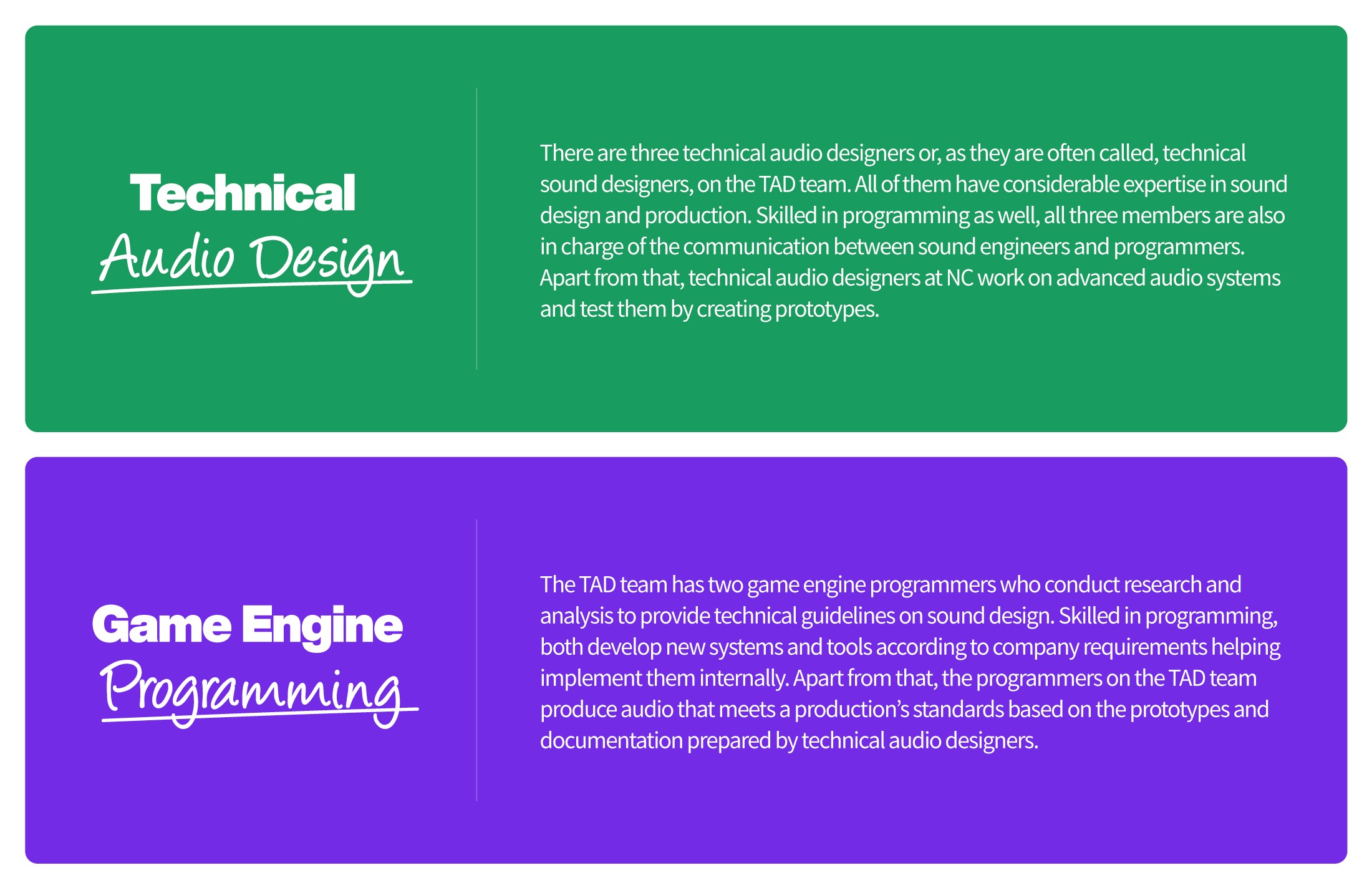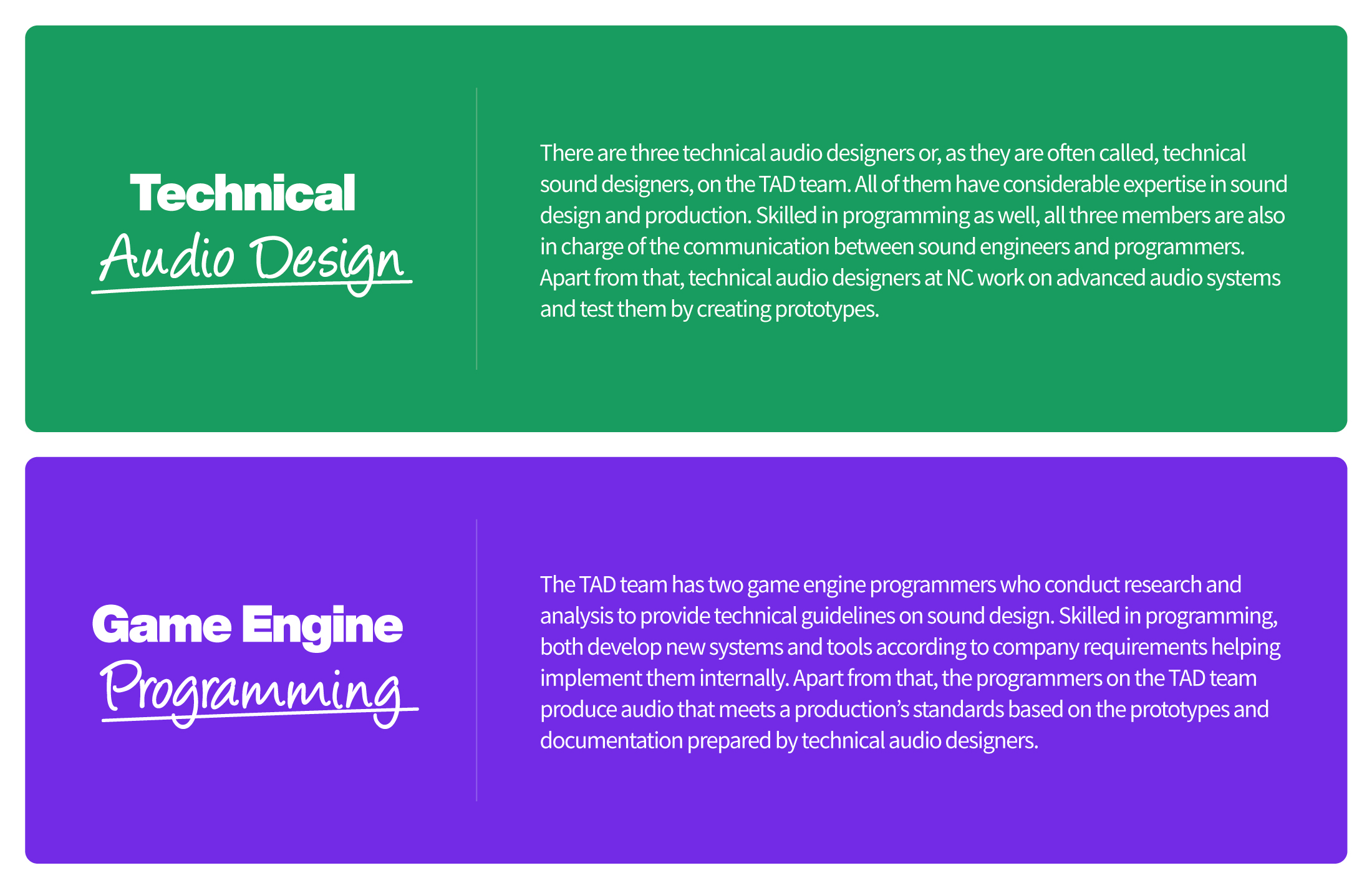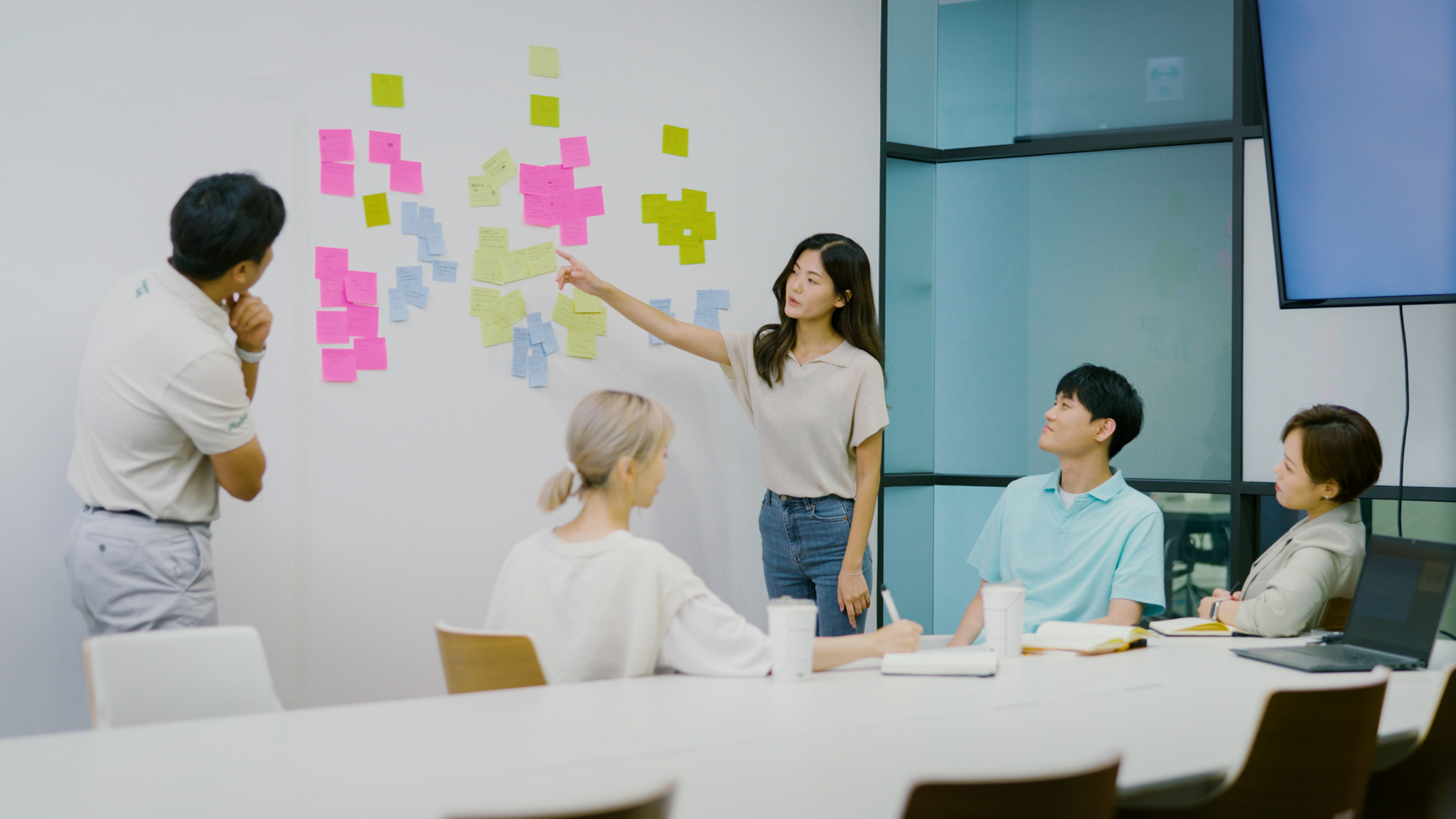NC Building a Creators' Playground
In game development, a positive and supportive team environment is a space that promotes high productivity, with employees generating creative ideas and making games look realistic. That is why teams at NC consist of specialists with considerable expertise who are able to incorporate their unique personalities into a game.
Developing a game means creating a new world, and these new worlds are created by outstanding teams with unique members. Being a game developer, NC also has a special organizational culture where employees can freely express themselves treating work like play.
WE PLAY is a series about different teams that create game worlds in a positive and fun work environment. In this article, we will talk about the TAD team and their definition of fun. The TAD team works together with the NC Sound Center, studying new audio technology and developing various tools for internal use.
Creative approach to game audio technology
TAD stands for “Technical Audio Design.” The team has five members who keep up with game audio technology trends. They also design or suggest audio systems based on project requirements.
Apart from the aforementioned responsibilities, the TAD team designs and develops various tools that are instrumental in achieving a unique NC sound within game engines and audio middleware plug-ins. The team also helps other teams by responding to their inquires about game audio technology.
Tandem of sound design and programming
The team's responsibilities are divided into two areas—Technical Audio Design and Game Engine Programming.
Moreover, audio designers and programmers on the TAD team share some responsibilities—they not only research and analyze game audio technology but also suggest technical solutions and address sound-related issues that occur in game development.
Mutual respect encourages creativity
As treating everyone with respect is one of the TAD team’s ground rules, they stay true to the principle of open communication in every possible situation.
Personality diversity for increased productivity and better engagement
The TAD team is a personality-diverse team; they value each other and encourage diversity of opinions. There are five people on the TAD team—Park Jung Kun, Kim Min Jung, Lee Han Kyul, Shin Hyeong Cheol, and Jeon Hui Jae—and each member has the utmost respect for the others even when they happen to disagree.
The team members are all different ages and have different backgrounds, however everyone on the team embraces this diversity.
With complementary skills in design and programming, the TAD team fills in each other’s gaps and is able to provide highly satisfactory audio experiences to a wide audience.
Professional growth through horizontal communication
The TAD team makes decisions by voting; when members don’t agree on something and can’t reach a decision, they vote (sometimes secretly) and decide by majority. After all members vote, they always make sure to listen to the other’s side opinion and, if necessary, revote sometimes arriving at a different decision.
Besides the majority vote, the team came up with a special system that they called “Super Pass.” When a team member feels strongly about something, they can assign greater weight to their opinions. For instance, in case the vote is split 3 to 2, the person with the “Super Pass” has the ability to cast two votes instead of one.
Every quarter of the year, the TAD team evaluates their work and assesses the effectiveness of their decisions. This allows the team to find motivation for further growth on both personal and professional levels.
Improving teamwork through face-to-face meetings
The TAD team has a special way of improving their teamwork—they hold short meetings every one or two weeks and give informative presentations on different topics. At such meetings, each presenter decides who will present after them.
These meetings help the team members to better understand each other and build trust, as their share personal information about their interests and professional growth plans.
Achieving effective teamwork with bots
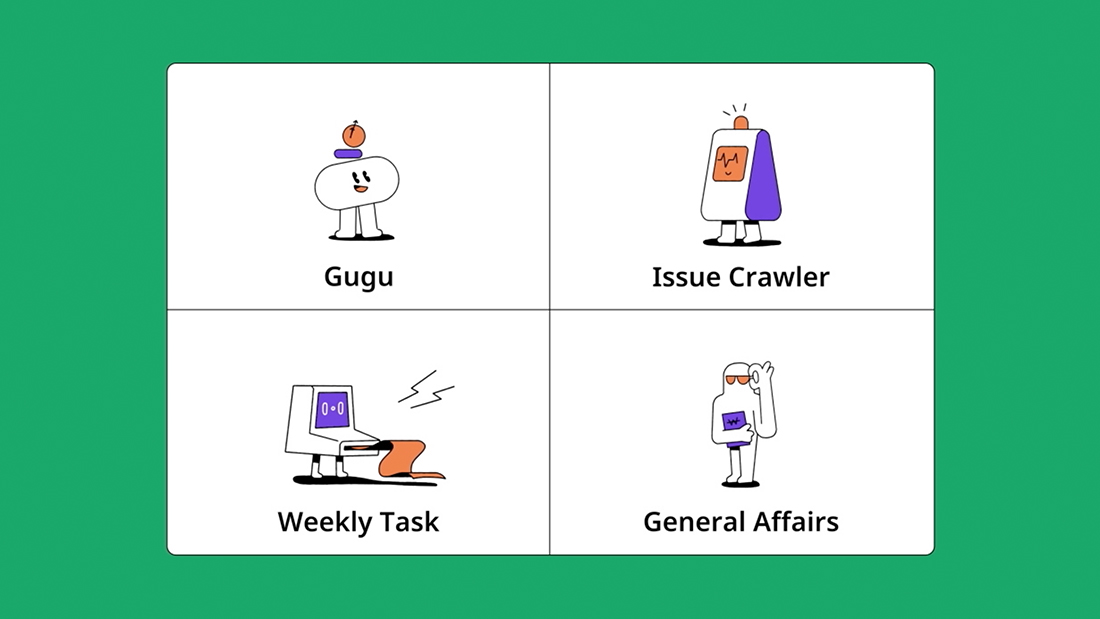

The TAD team values efficiency more than anything, which is why they developed bots that help the team automate repetitive tasks. These bots play an important role in achieving efficiency and can be rightfully called the TAD team’s sixth member.
Since the TAD team helps other teams by responding to their inquiries about game audio technology, they developed the Audio Technology Q&A Bot that checks the status of these inquiries. Moreover, their Issue Crawler Bot collects information on issues that occur in external systems such as Unreal Engine and Wwise and alerts the team about them.
Gugu checks the team’s workload and books a meeting room if necessary, sharing a meeting agenda as well. The team’s budget is managed by the General Affairs Bot—it checks their expenses and shares information on the remaining amount.
The team also developed a web application that helps them organize their time. The NTS (Nine-To-Six) app is their digital secretary that checks availability of all team members, plans a meeting, and estimates its approximate duration.
Moreover, the TAD team automated report writing with the help of the Weekly Task Bot that automatically summarizes each person's tasks for reporting purposes.
Thanks to these bots, the team can utilize their working hours with greater flexibility and efficiency, focusing more on creative tasks and idea generation.
Good teamwork leads to breakthrough creativity
Everyone on the TAD team is interested in the latest audio technology and keeps up with new trends. Together they conduct research, develop new tools, and implement them internally. However, that is not all—the team also holds patents for their inventions.
Sharing research findings and creating sound
The TAD team has completed some important R&D projects. For instance, the team researched object destruction sounds to achieve a more realistic sound when objects get destructed or exploded in games. They also researched gunshot sound effects to fix sound lag during gunfire and looked into developing plug-ins for Wwise, a sound middleware for games.
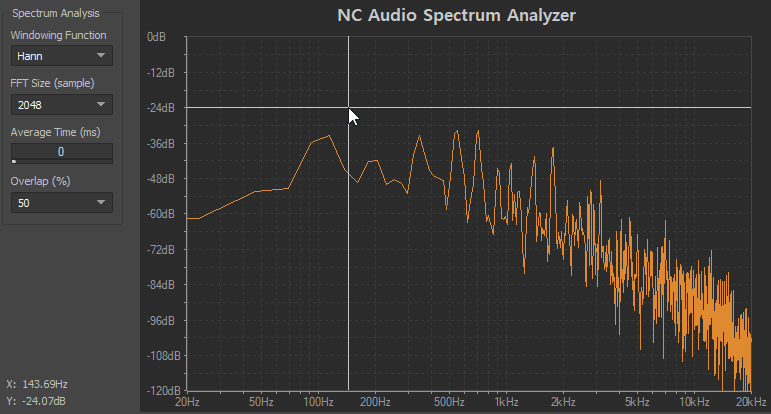

*Audio data visualization in Wwise. This plug-in analyzes the output audio signal and visualizes the decibel scale (dB) according to the frequency (Hz).
The team developed several useful tools and implemented them internally. Among them are 'Wwise Project Structure Visualization Tool,’ 'Voice Sound Conversion/Management Tool’ and 'Wwise Data Input/Modification Utility Tool.’ They also developed helpful plug-ins that include 'Animation Sound Placement Automation Plug-in,’ 'Environmental Sound Placement Automation Plug-in' and 'Spatial Sound Automation Plug-in.’ These tools and plug-ins helped automate certain processes and minimize repetitive tasks, which resulted in higher efficiency at NC.
Treating work like play and boosting originality
The TAD team belongs to the Sound Technology Research TF that received a patent for inventing a device that computes acoustic effects. The findings provide a new acoustic method that will undoubtedly contribute to achieving new levels in sound technology.
The patent presents new findings on reverberation—it is created automatically based on the spatial information which is analyzed with the help of ray casting. (*Ray casting is a technique that analyzes surface through emitting invisible light in a virtual space.)
In other words, since this computing device has a processor and a memory, it can store executable programs. This device is able to emit rays in a virtual space, analyze this virtual space, and automatically generate reverberation.
In short, ray casting helps analyze the space around the character and generate reverberation. If in past, sound designers had to input reverberation effects manually according to the changes in the environment, now this is successfully automated. The TAD team also considered how to optimize the existing MMORPG environment through this research.
Apart from this, the Sound Technology Research TF has applied for two more patents—one deals with the method of expressing sound occlusion and the other deals with the method of automatically arranging ambient sound in a game.
The TAD team is a creative team, with all members respecting each other. They value open communication, seek diversity of opinions and viewpoints and, most importantly, listen to each other. At NC, we promote an open organizational culture and believe that transparency helps achieve better efficiency. The TAD team takes full advantage of this open system, allowing them to produce incredible results, while still having fun. NC takes pride in helping employees realize their full potential in an environment where they can treat work like play.
 Facebook
Facebook  Twitter
Twitter  Reddit
Reddit  LinkedIn
LinkedIn  Email
Email  Copy URL
Copy URL 